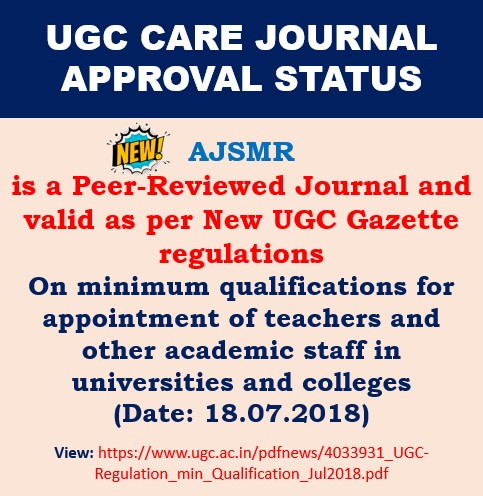Original Research Article I Volume 3 I Issue 4 I 2017
In vivo inhibitory effect of Diclofenac on Succinate dehydrogenase and Acetylcholinesterase enzymes in the tissues of Channa punctatus
Rohini Padma, Prameela Devi Yalavarthy
The American Journal Science and Medical Research; 3(4); 10-14
DOI:http://dx.doi.org/10.17812/ajsmr3403
Abstract:
Pharmaceuticals have emerged as priority pollutants of the environment all over the world in recent times. Diclofenac is a non-steroidal anti-inflammatory drug that has been usually detected in surface waters in the range of ng/l to µg/l. There are many experimental evidences on its toxicity in the aquatic flora and fauna. The objective of the present study is to investigate the acute toxic effect of the drug, Diclofenac in the fresh water fish, Channapunctatus. The fish were exposed to ten different concentrations of Diclofenac for 96 hours. The median lethal concentration value was evaluated by Probit analysis. Later the fish were exposed to sub lethal and lethal concentrations of diclofenac for a period of 96 hours. The effect of Diclofenac was observed in five different tissues like gill, kidney, brain, liver and muscle. Succinate dehydrogenase enzyme was estimated by Nachlaset al., method (1960). Acetylcholinesterase enzyme activity was estimated by Ellman method (1961). There was remarkable inhibition in the activity of the two enzymes studied. The inhibition was found to be significant and dose dependent. This study signifies that enzymes are the effective biomarkers to find out the biochemical alterations in toxic studies. It also assumes that pharmaceutical residues in the water deteriorate the health of the fish.
Keywords:
Diclofenac, acute toxicity, enzymes, Channapunctatus
References:
Skoutakis V.A, Carter C.A, Mickle T.R, Smith V.H. andArkin C.R, Alissandratos J, Petty D.E.,Review of diclofenac and evaluation of its place in therapy as a nonsteroidalantiinflammatory agent.Drug Intell&Clin Pharm,
[2]. Brogen R.N, Pakes G.E, Speight T.M, Avery G.S. 1980; Diclofenac sodium: a review of its pharmacological properties and therapeutic use in rhematic diseases and pain of varying origin. Drugs, 20: 24‐48.
[3]. Buser H.R,PoigerT, and Müller M.D. 1998; Occurrence and Fate of the Pharmaceutical Drug Diclofenac in Surface Waters: Rapid Photodegradation in a Lake. Environ. Sci. Technol, 32 (22): pp 3449- 3456.
[4]. Cuklev F, Kristiansson E, Fick J, Asker N,Förlin L, Larsson D.G.J. 2011; Diclofenac in fish: Blood plasma levels similar to human therapeutic levels affect global hepatic gene expression. Environ toxicology and chemistry, 30 (9): pp 2126-2134.
[5]. Nagaraju B. and Venkatarathnamma V. 2013; Effect of Profenofos an organophosphate on protein levels in some tissues of fresh water fish, Labeorohita (Hamilton). International Journal of Pharmacy and Pharmaceutical Sciences. 5(1), pp 276-279.
[6]. SavithaYadav Rao W and Wani G.P. 2014; Effect of polo (an insecticide) on protein contents of liver and gonad of fresh water fish, Labeorohita. International research Journal of Pharmacy. 5(10) pp 792-794.
[7]. Nachlas MM, Margulius SD and Seligman AM. A colorimetric method for estimation of succinic dehydrogenase activity. Journal of Biological Chemistry, 1960; 235: 499-504.
[8]. Ellman GL, Courtney KD, Andres VJ, Featherstone RM. A new and rapid colorimetric determination of acetylcholinesterase activity. BiochemPharmacol 1961; 7:88-95.
[9]. Sastry KV, Siddiqui AA (1982) Chronic toxic effects of the carbamate pesticide Sevin on carbohydrate metabolism in a freshwater snakehead fish,Channapunctatus. ToxicolLett 14:123–130.
[10]. Impact of Distillery Effluent on Carbohydrate Metabolism of Freshwater Fish, CyprinuscarpioEcotoxicology, October 2005, 14 (7), 693–707.
Article Dates:
Received: 22 November 2017 ; Accepted: 25 December 2017; Published: 31 December 2017
How To Cite:
http://dx.doi.org/10.17812/ajsmr34003 Received :22 November, 2017 Accepted; 25 December, 2017 Available online : 31 December, 2017



